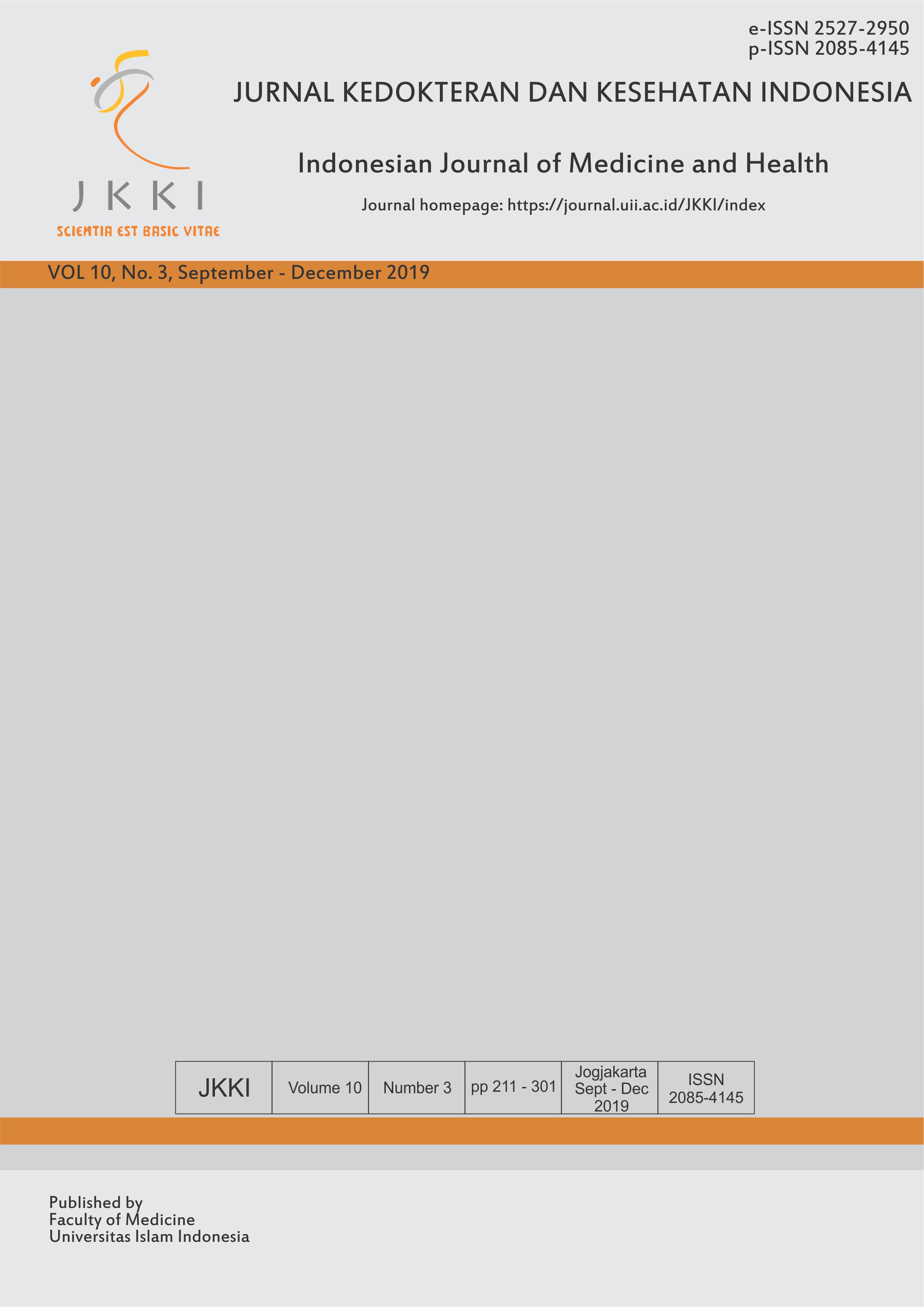Main Article Content
Abstract
Background: The World Health Organization (WHO) has recommended using fixed dose combination (FDC) for tuberculosis treatments as it can improve patient compliance and prevent drug resistance. A combination of rifampicin and isoniazid can cause reductions in concentration of each drug because the rifampicin is labile and can not be mixed with all three other TB drugs
Objective: This study is aimed to understand effects of the combination of both physical properties and dissolutions of rifampin.
Methods: This laboratory study observed rifampicin tablets and combination tablets of rifampicin and isoniazid (2 FDC) by testing physical properties of the tablets and dissolution tests. Friability test was conducted by using friability tester, hardness test was by hardness tester, disintegration test was by disintegration tester and dissolution test was by dissolution tester type 1 (basket). Its data were analysed by Mann Whitney test. The data had value if p<0.05 with CI 95%.
Results: This study found that each tablet of rifampicin and 2 FDC tablets respectively had averages of 0.25% and 0.14% of brittleness, 11.07 kg and 10.19 kg of hardness, 2 minutes 1 second and 10 minutes 9 seconds of disintegration time. Consequently, the generic rifampicin tablets were more fragile but harder and faster to crumble than the 2 FDC tablets, in which their mean values were DE45 92.03% and 93.94%. Based on statistical test of Mann Whitney on the rifampicin tablets and 2 FDC, there were no significant differences of hardness test result and mean DE45 0.076(p>0.05 ), while there were significant difference of fragile test result and disintegration time 0.015(p<0.05).
Conclusion: The combination of rifampicin and isoniazid in tablet 2 Fixed Dose Combination (2 FDC) had no effects on the dissolution rates of rifampicin, but they had effects on some parameters of physical property test of the tablets.
Keywords
Article Details
Authors who publish in the Jurnal Kedokteran dan Kesehatan Indonesia agree to the following terms:
- Authors retain copyright and grant Jurnal Kedokteran dan Kesehatan Indonesia right of first publication with the work simultaneously licensed under a Creative Commons Attribution Licence that allows others to adapt (remix, transform, and build) upon the work non-commercially with an acknowledgement of the work's authorship and initial publication in Jurnal Kedokteran dan Kesehatan Indonesia.
- Authors are permitted to share (copy and redistribute) the journal's published version of the work non-commercially (e.g., post it to an institutional repository or publish it in a book), with an acknowledgement of its initial publication in Jurnal Kedokteran dan Kesehatan Indonesia.
References
- Joke RW, Sugiarso, CN, Widianto, BM, Sukandar, et al. Farmakodinamik dan Terapi Antibiotik. Yogyakarta, Indonesia: Universitas Gadjah Mada Yogyakarta. 1991: 136,334.
- Mycek MJ, Harvey, Richard A, Champe, CP. Farmakologi?: Ulasan Bergambar. 2nd ed. Jakarta Indonesia: Widya Medika; 2001. 335-8.
- Depkes RI. Info DATIN?: Tuberkulosis Temukan Obati Sampai Sembuh. Jakarta Indonesia: Departemen Kesehatan RI; 2016.
- Hao LH, Guo SC, Liu CC, Zhu H, Wang B, Fu L, et al. Comparative bioavailability of rifampicin and isoniazid in fixed dose combinations and single-drug formulations. International Journal Tuberculosis Lung Disease 2014;18(12):1505–12.
- Shargel L, Wu-pong S, B.C.Yu A. Biofarmasetika & Farmakokinetika Terapan. 5th ed. Surabaya Indonesia: Universitas Airlangga. 2012: 413-50.
- Agoes G. Pengembangan Sediaan Farmasi. revisi dan. ITB, editor. bandung: ITB; 2008. pp: 290-2,296-7.
- Depkes RI. Farmakope Indonesia. V. Jakarta Indonesia: Departemen Kesehatan RI; 2014. pp: 57,1613,1094,1098-9,1611.
- The promise and reality of fixed-dose combinations with rifampicin. A joint statement of the international union against tuberculosis and lung disease and the tuberculosis programme of the World Health Organization. Tuberculosis Lung Disease. 1994 Jun;75(3):180–1.
- Kasim NA, Whitehouse M, Ramachandran C, Bermejo M, Lennernäs H, Hussain AS, et al. Molecular Properties of WHO Essential Drugs and Provisional Biopharmaceutical Classification. Molecular Pharmaceutic. 2004. 1(1):85–96.
- Panchagnula R, Agrawal S. Biopharmaceutic and pharmacokinetic aspects of variable bioavailability of rifampicin. International Journal Pharmaceutics. 2004. 271(1–2):1–4.
- Agrawal S, Kaur KJ, Singh I, Bhade SR, Kaul CL, Panchagnula R. Assessment of bioequivalence of rifampicin, isoniazid and pyrazinamide in a four drug fixed dose combination with separate formulations at the same dose levels. International Journal Pharmaceutics. 2002. 233(1–2):169–77.
References
Joke RW, Sugiarso, CN, Widianto, BM, Sukandar, et al. Farmakodinamik dan Terapi Antibiotik. Yogyakarta, Indonesia: Universitas Gadjah Mada Yogyakarta. 1991: 136,334.
Mycek MJ, Harvey, Richard A, Champe, CP. Farmakologi?: Ulasan Bergambar. 2nd ed. Jakarta Indonesia: Widya Medika; 2001. 335-8.
Depkes RI. Info DATIN?: Tuberkulosis Temukan Obati Sampai Sembuh. Jakarta Indonesia: Departemen Kesehatan RI; 2016.
Hao LH, Guo SC, Liu CC, Zhu H, Wang B, Fu L, et al. Comparative bioavailability of rifampicin and isoniazid in fixed dose combinations and single-drug formulations. International Journal Tuberculosis Lung Disease 2014;18(12):1505–12.
Shargel L, Wu-pong S, B.C.Yu A. Biofarmasetika & Farmakokinetika Terapan. 5th ed. Surabaya Indonesia: Universitas Airlangga. 2012: 413-50.
Agoes G. Pengembangan Sediaan Farmasi. revisi dan. ITB, editor. bandung: ITB; 2008. pp: 290-2,296-7.
Depkes RI. Farmakope Indonesia. V. Jakarta Indonesia: Departemen Kesehatan RI; 2014. pp: 57,1613,1094,1098-9,1611.
The promise and reality of fixed-dose combinations with rifampicin. A joint statement of the international union against tuberculosis and lung disease and the tuberculosis programme of the World Health Organization. Tuberculosis Lung Disease. 1994 Jun;75(3):180–1.
Kasim NA, Whitehouse M, Ramachandran C, Bermejo M, Lennernäs H, Hussain AS, et al. Molecular Properties of WHO Essential Drugs and Provisional Biopharmaceutical Classification. Molecular Pharmaceutic. 2004. 1(1):85–96.
Panchagnula R, Agrawal S. Biopharmaceutic and pharmacokinetic aspects of variable bioavailability of rifampicin. International Journal Pharmaceutics. 2004. 271(1–2):1–4.
Agrawal S, Kaur KJ, Singh I, Bhade SR, Kaul CL, Panchagnula R. Assessment of bioequivalence of rifampicin, isoniazid and pyrazinamide in a four drug fixed dose combination with separate formulations at the same dose levels. International Journal Pharmaceutics. 2002. 233(1–2):169–77.
